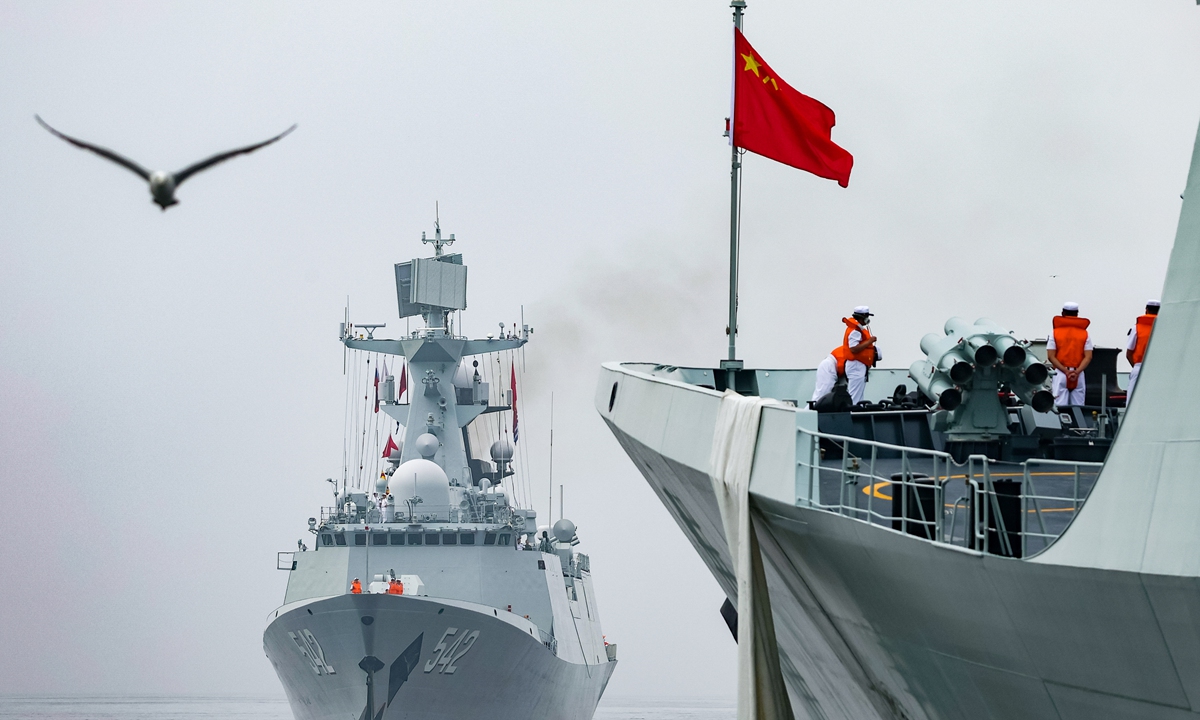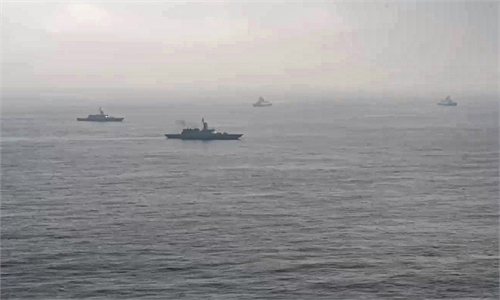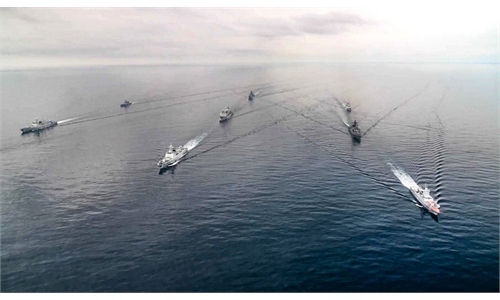China-Russia joint drills wrap up in Sea of Japan, to be followed by joint naval, air patrols in Pacific Ocean

The Zaozhuang frigate is seen during a ceremony to finish the North/Interaction-2023 joint naval drills held by Russia and China in the Sea of Japan on July 24, 2023. Photo: VCG
China and Russia successfully wrapped up the four-day Northern/Interaction-2023 joint exercises in the Sea of Japan on Sunday and are expected to switch to the next phase of joint naval and air patrols in the Pacific Ocean.
Highly combat-oriented and practical, the drills displayed the two countries' high level of military cooperation in the face of security threats, experts said on Monday.
A closing ceremony was held on board the Type 052D destroyer Qiqihar of the Chinese People's Liberation Army (PLA) Navy, which served as the command ship for the drills, the PLA Navy said in a press release on Monday.
In the four days of intense joint military exercises, the naval and air forces from both countries completed multiple training objectives including sea-air integrated escort and deterrence expulsion, as they switched between joint formations and combat groups and practiced live fire surface-to-air shooting with ship-borne weapons systems, according to the press release.
The drills met the expected goals of deepening mutual trust, enhancing friendship and boosting capabilities, the PLA Navy said.
"The exercises marked a major China-Russia joint combat operation in safeguarding the security of strategic maritime routes, as well as an important move in implementing the two militaries' sea-air integrated joint capabilities," said Rear Admiral Qiu Wensheng, the commander of the Northern/Interaction-2023 exercise.
The drills promoted the two countries' strategic cooperation as well as the safeguarding of stability in Northeast Asia, Qiu said.
Song Zhongping, a Chinese military expert and TV commentator, told the Global Times on Monday that the exercises practiced anti-sea mine, anti-aircraft, anti-ship and anti-submarine operations, which closely matched the theme of safeguarding strategic maritime routes.
The Sea of Japan features key strategic channels including the Soya Strait, the Tsugaru Strait and the Tsushima Strait.
While the exercise did not target any third party, Song pointed out that it came at a time when some major geopolitical powers are creating huge security threats in the region.
It also reflected a high level of mutual trust between the Chinese and Russian militaries, Song said.
According to official releases and media reports, the Chinese side sent the Type 052D guided missile destroyers Qiqihar and Guiyang, the Type 054A guided missile frigates Zaozhuang and Rizhao, and the Type 903 comprehensive replenishment ship Taihu at sea, and the Y-20 large transport aircraft, the KJ-500 early warning aircraft, the J-16 fighter jet and the Z-20 helicopter in the air, while the Russian side sent the large anti-submarine ships Admiral Tribunts and Admiral Panteleev as well as the corvettes Gremyashy and Hero of the Russian Federation Aldar Tsydenzhapov in addition to different types of aircraft.
Both China and Russia deployed their main combat weapons and equipment to the exercise, and the training courses were designed to be complex and combat oriented, another Chinese military expert, who requested anonymity, told the Global Times on Monday.
The fleet of around 10 vessels and 30 aircraft demonstrated capabilities in safeguarding peace and stability in the region amid a deterioration in the global security situation, the expert said.
With the end of the Northern/Interaction-2023 joint exercise, the Chinese and Russian naval and aviation forces are scheduled to go on and hold joint patrols in Pacific waters, according to a PLA Navy announcement on July 15, when the Chinese vessels set out for the exercise.
This could be the first time that the two countries hold a joint naval and air patrol, Song said.
China and Russia have had two joint naval patrols. One came after the Joint Sea-2021 naval drills in 2021, which saw Chinese and Russian navies form a joint flotilla and sail across the Sea of Japan, the West Pacific and the East China Sea in seven days in their first joint naval patrol, marking a circumnavigation around Japan. The other came after the Russia-led Vostok-2022 strategic drills in 2022, also in the Pacific Ocean.
The two countries also regularly hold joint aerial strategic patrols. The sixth patrol was held in June this year.
The upcoming joint naval and air patrol will be another manifestation of the increasingly enhanced strategic cooperation between China and Russia, analysts said.



